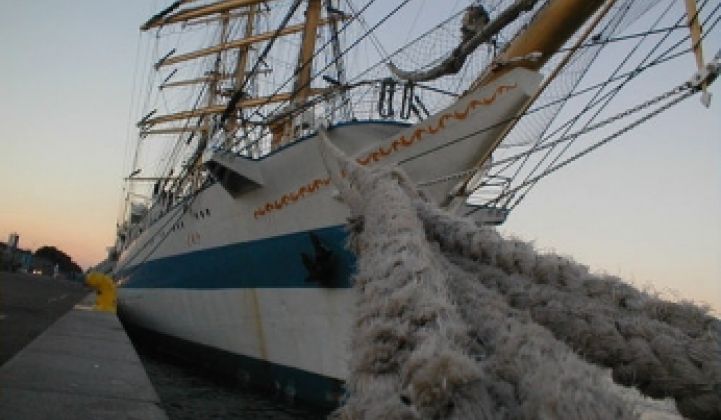If you are looking for the next big idea in greentech, you might want to take a walk along the waterfront.
Ports – those ocean gateways long associated with water pollution, hazardous substances, workers compensation claims and "discount" merchandise – are really an untapped resource for the green industry, says Julian Gresser, an attorney with Manatt, Phelps and Phillips and one of the architects behind a proposal to get a "green ports" amendment in the American Clean Energy and Security Act of 2009.
"Eighty percent of every major industry depends on ports yet there is not a single mention of ports in the energy bill," he said. (Ports, however, did get about $35 billion under $787 American Recovery and Reinvestment Act.)
Gresser makes a somewhat compelling case for LEED-like standards and stimulus funding. Ports remain a major employer of blue collar labor, and one of the purposes of the energy bill will be to grow jobs in transportation, construction and other fields. Ports have also long been associated with diseases and environmental and health hazards. West Oakland, right near the industrial waterfront of Oakland, Calif., has a cancer rate that's three times the regional average.
Additionally, ports are historically tightly linked to major urban hubs, the same place where you find research universities. With some massaging and guidance, tech-transfer offices could encourage collaboration between departments and the development of marine technology incubators. In some places, it could be easy: On the UC Berkeley campus, the sparkling new Center for Information Technology Research in the Interest of Society (CITRIS) sits next to the Department of Naval Architecture.
And for extra credit, there's this. Unlike some traditional industries, ports aren't as technology adverse as one might think.
"It has gone from zero-tech to high-tech in 10 years," said Bill Lyte, Chairman of the Harbor Association of Industry and Commerce. Modernization began after Sept. 11, 2001. Ports were viewed as potential gateways for terrorism, which lead to an influx of inspection and security technology. Port shutdowns in 2003 over a labor dispute then lead to the introduction of GPS, RFID and other container tracking technologies.
"They did everything on paper prior to that because they were afraid of losing jobs," Lyte said.
A year later, new environmental regulations began to take shape aimed at reducing fuel consumption and emissions.
Some of the more interesting ideas we've seen:
- The Advanced Emissions Control System from Advanced Cleanup Technologies. Think of it as a 1.25-ton chef's hat for a smokestack. ACT puts a bonnet on ships in port that can reduce sulfur dioxide emissions by 97 percent, particulate matter by 92 percent. Although ships will ultimately have to get retrofitted, ACT's bonnet can serves effectively as a capital-lite solution for now. The company demonstrated it at Long Beach last year. The Ports of Los Angeles and Long Beach want to reduce particulate emissions by 45 percent by 2011. Ships accounts for around 59 percent of particulates.
- Vycon Energy's Regen Crane Energy Storage System. The Regen system applies the same principles as the regenerative braking system in a Prius, but on a larger scale. Energy harvested from lowering tons of cargo onto docks is fed back to the crane and used to pull cargo out of the hold. Overall, the Regen system can reduce fuel consumption by 38 percent, according to the company. Hutchison Wampoa conducted tests at the Yantian International Container Terminal in Shenzhen, China last year with the crane and, based on the results, bought more of them and began encouraging other port operators to take a look. (We have more coming on Vycon.)
- The paint-cleaning robot from EcoSphere Technologies. Check out the video and photographs in this News.com story. (Disclosure: I wrote it.) The robot blasts a high pressure water stream onto a ship's hull to scrape of paint. Not only does it eliminate the need for dirty sandblasting operations, the robot sequesters the extremely toxic paint solids, speeding cleanup and dry dock maintenance.
- The Dragon Power Station from AEST. The Dragon consists of plates in a roadway that harvest kinetic energy from vibrations and turn it into electricity. It works on the same principles as those experimental harvesters that generate power from footsteps, but with multi-ton trucks rather than 150-pound museum goers. The Port of Oakland has tested one for the past few years.
Going from promise to practical, however, could take years. Many of the technologies will have to undergo tests with air and water quality boards, which can take years. Institutional inertia also must be overcome.
"The port community is very fragmented. Ports are made up of several different industries," said Lyte. "They don't tend to work together as a group."
Another challenge: Ships only spew some of their greenhouse gases in port. A U.N. study last year estimated that 4.5 percent of greenhouse gases can be attributed to shipping, or over a billion tons of carbon dioxide. That came to more than double aviation. Thus, greening ports would only impact the problem of marine pollution so much.
Gresser and Lyte, however, are already pursuing industry partners and politicians such as Nancy Pelosi and John Kerry.
"There is a wonderful harmony between efficiency and green here," said Gresser.
Image courtesy Flickr / Creative Commons



